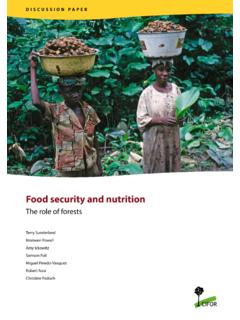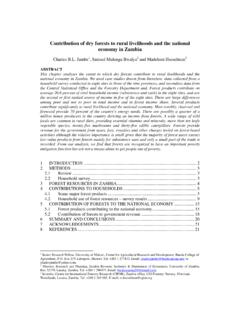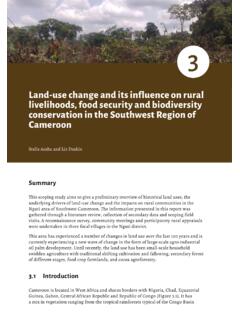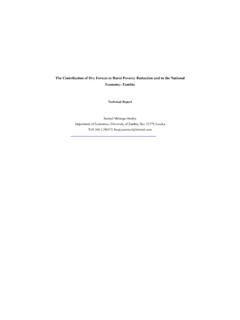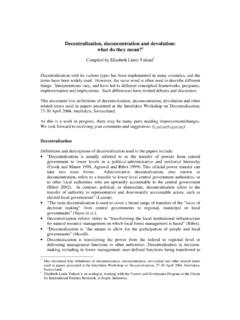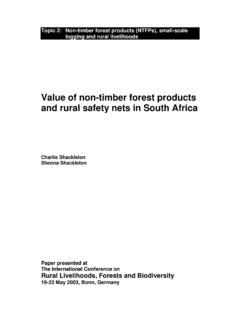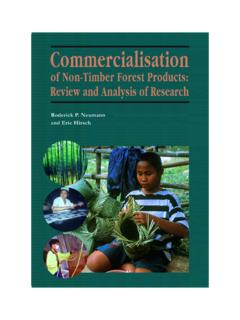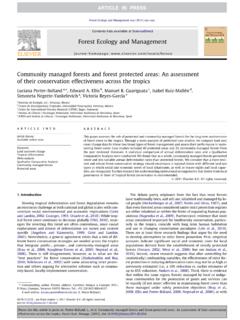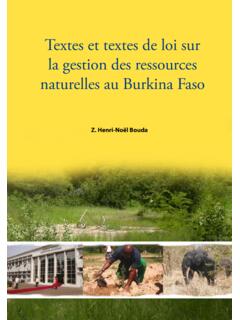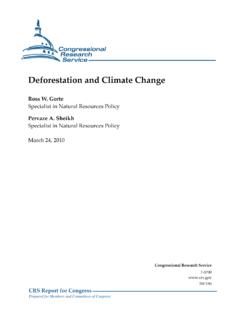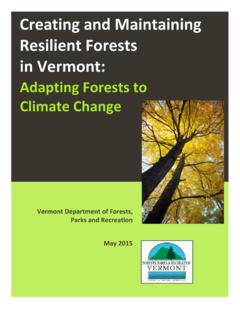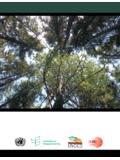Transcription of Forests for climate change adaptation in the congo basin
1 No. 2 November 2008No. 2 November 2008 Johnson Nkem, Monica Idinoba, Cyrie SendashongaKey pointsRaising policy and public awareness on climate change and discussing the need for adaptation the congo basin s carbon potential for sustainable economic growth, climate change mitigation, and improved local emerging market opportunities and their limitations for equitable cash ows, goods and services provision and national ecological safety nets in Forests so that valued resources are more resilient to climate variability and change . Balancing the interests of multiple stakeholders when setting priorities intended to achieve the Millennium Development Goal s, national economic growth and sustainability public participation in a science-policy dialogue throughout the process. An innovative framework is needed whereby goods and services from sustainably managed congo basin Forests are integrated into climate change adaptation strategies. Such strategies should also contribute to poverty reduction and biodiversity conservation in a way that enhances the Forests ecological resilience to climate impacts.
2 For a region where livelihoods and national development are closely linked to natural resources, choosing the best pro-poor pathway for climate change adaptation is fundamental to sustainability and poverty alleviation. An understanding of ecosystem services and their trajectories in future climate scenarios will be required. Participation by multiple stakeholders, including women and minority groups such as indigenous communities, is crucial to ensure their interests are reflected in national planning and policies. This information brief reiterates the opportunities for integrating poverty alleviation and climate change adaptation strategies into an ecosystem approach1 to regional forest policy and management. Carbon capital of the congo basin and climate changeAn estimated 25-30 million tons of carbon stocks are locked in the vegetation in the congo basin Forests (Hoare 2007) and more than twice as much in the soil and litter sinks. However, these Forests are vulnerable to activities such as slash-and-burn farming, and logging, which release substantial carbon stocks and thus contribute to global climate change .
3 On a global scale, agricultural and forestry activities are the second largest source of human-induced greenhouse gas emissions after burning fossil 3 CIFOR initiative on climate change and forestCIFOR s approach is to create an environment for climate change adaptation whereby stakeholders and partners are brought together to set the agenda and the implementation plan of activities that re ect local livelihood and national development priorities. With support from the International Development Research Centre climate change adaptation for Africa program, CIFOR s congo basin Forests and climate change adaptation project is undertaking research in the congo basin forest with the vision of generating public awareness and developing a critical mass for planning adaptation strategies, as well as contributing to the knowledge base required in using forest ecosystem services for climate change adaptation , and mainstreaming this into national development. Working with multiple stakeholders in a participatory action approach, the project balances the multiple interests of the stakeholders and identi es their special needs for part of the adaptation effort, focusing on spatial strategies, such as ecological networks, short-term refugia, robust corridors, transnational pathways, or potential future protected the safety net roles of Forests are critical to the livelihoods of millions of rural poor, they also play an important role in the national economy by maintaining market routes and networks for a large part of the population engaged in marketing forest products.
4 There is great, unrecognized potential for climate change adaptation as well as poverty reduction through using these markets more effectively to generate revenue and diversify livelihood actions by national and international policymakers, local producer organizations, the forest business community, and civil society and donor organizations is required to harness market trends towards the development of sustainable local livelihood systems. Regional institutional pathways such as the Central African forest Commission (COMIFAC) provide an important platform for an ecosystem approach in responding to climate change and achieving synergy between mitigation and adaptation strategies. Policies that protect the weak and vulnerable while balancing multiple interests and activities contributing to human wellbeing and national development should be approach (IPCC 2007). The ecosystem approach is a strategy for the integrated management of land, water and living resources that promotes conservation and sustainable use in an equitable way.
5 An ecosystem approach is based on applying appropriate scientific methodologies focused on levels of biological organisation, which encompass the essential structure, processes, functions and interactions among organisms and their environment. It recognizes that humans, with their cultural diversity, are an integral component of many ecosystems. The ecosystem approach requires adaptive management to deal with the complex and dynamic nature of ecosystems and the absence of complete knowledge or understanding of their functioning. Priority targets are conservation of biodiversity and of the ecosystem structure and functioning, in order to maintain ecosystem 2006. The State of the congo basin : State of the Foresy , L., Hart, T., Kaimowitz, D., Karsenty, A. and Topa, G. (Eds.) 2007 Forests in Post- Conflict Democratic Republic of congo : Analysis of a Priority Agenda. A joint report by teams of the World Bank, Center for International Forestry Research (CIFOR), Centre International de Recherche Agronomique pour le D veloppement (CIRAD), African Wildlife Foundation (AWF), Conseil National des ONG de D veloppement du congo (CNONGD), Conservation International (CI), Groupe de Travail For ts (GTF), Ligue Nationale des Pygm es du congo (LINAPYCO), Netherlands Development Organisation (SNV), R seau des Partenaires pour l Environnement au congo (REPEC), Wildlife Conservation Society (WCS), Woods Hole Research Center (WHRC), World Agroforestry Centre (ICRAF) and World Wide Fund for Nature (WWF).
6 Xxii, 83p. ISBN 979-24-4665-6 Democratic Republic of congo 2007. Poverty Reduction Strategy Paper. International Monetary Fund; IMF Country Report No. 07 , , Loux, B., Yamana, , Bomblies, A. 2004. A see-saw oscillation between the Amazon and congo basins. Geophysical Research Letters , J. J., Oleson, K. W., Bonan, , Mearns, , Buja, , Meehl, , Washington, 2005. The importance of land-cover change in simulating future climates. Science 310, 1674-1678 Katerere, Y., Keterere, M. 2005. From poverty to prosperity: Harnessing the wealth of Africa Forests . In IUFRO s Special Project on World Forests , Society and Environment (WFSE)Malhi, M., Wright, J. 2004. Spatial patterns and recent trends in the climate of tropical rainforest regions. Phil. Trans. R. Soc. Lond. B 359, 311-329 Scherr, , White A., Kaimowitz D. 2004. A New Agenda for forest Conservation and Poverty Reduction: Making Markets Work for Low-Income Producers 2004 forest TrendsStern 2006. Stern Review on the Economics of climate ChangeUnited Nations Economic Commission for Africa, 2008 Sustainable Development Report on Africa.
7 Publications Economic Commission for Africa Box 3001 Addis Ababa, EthiopiaUNDP & UNICEF 2002. The Millennium Development Goals in Africa: promises and progress. Report prepared by UNDP and UNICEF at the request of the G-8 Personal Representatives for Africa New York. June 2002 World Bank Inspection Panel investigation Report, 2007. DEMOCRATIC REPUBLIC OF congo : Transitional Support for Economic Recovery Grant (TSERO) (IDA Grant No. 1920-DRC) and Emergency Economic and Social Reunification Support Project (EESRSP) (Credit No. 3824 DRC and Grant No. H 064-DRC) August 31, 2007 For further information, please contact: Johnson Nkem Idinoba Sendashonga full length version of the paper can be found at: For general inquiries: for International Forestry Research (CIFOR) advances human well-being, environmental conservation, and equity by conducting research to inform policies and practices that a ect Forests in developing countries. CIFOR is one of 15 centres within the Consultative Group on International Agricultural Research (CGIAR).
8 CIFOR s headquarters are in Bogor, Indonesia. It also has o ces in Asia, Africa and South America. CIFOR works in over 30 countries worldwide and has links with researchers in 50 international, regional and national organisations. 1. The potential ampli cation of anthropogenic disturbances over time and space in the congo basin ForestsTemporalscale of impactSpatial scale of PhenomenaSelective LoggingMines, Hunting, CampAgro-industryRoad ConstructionSwidden AgricultureFirePoint source e ect that could spiral into non linear landscape scale phenomena with the ampli cation of climate impacts and the vulnerability of the Forests ecosystem and the provision of goods and services for adaptationCIFOR environment briefs provide concise, accurate, peer-reviewed information on current topics in forest researchCIFORNo. 2, November for climate change adaptation in the congo basinResponding to an urgent need with sustainable practicesNo. 2 November 2008No. 2 November 2008 Although the congo basin s overall annual CO2 emissions are low, deforestation and degradation account for 90 per cent (20-60 million tons per year) of its emissions.
9 Emerging evidence indicates that selective logging accounts for 25-50 per cent of the region s carbon losses (Hoare 2007), and also helps to open up new forest areas for activities such as slash-and-burn farming (Figure 1) that are likely to accelerate carbon and biodiversity losses. These secondary activities are estimated to release times more carbon than from selective logging alone (Greenpeace 2007). These emissions not only undermine the global response to climate change , but also reduce the local capacity to adapt to climate change impacts. For example, the Central African rainforest is naturally drier than the tropical rainforests of South America and South East Asia, and has become drier in recent decades (Malhi & Wright 2004). Projected temperature increases under climate change are likely to accelerate this trend, severely damaging the forest ecosystem and its capacity reliably to provide essential environmental services such as water supplies for local communities and power generation, and forest products that sustain local carbon capital locked in the forest biomass also plays a major role in water and other biogeochemical cycles with far-reaching consequences.
10 The Forests generate 75-95 per cent of regional rainfall through evaporation and evapotranspiration (WWF 2007), compared to 50 per cent in the Amazon basin and <20 per cent in Asian Forests . Evaporation from the basin contributes about 17 per cent of West Africa s rainfall (Eltahir et al. 2004). Deforestation will potentially cause a decline in rainfall as far away as North America and Europe (Feddema et al. 2005), and decline in water quality and quantity in the congo River which possesses 1/6th of the world s known potential for hydroelectric power (Maniatis 2007).This interconnected expanse of tropical forest allows uninterrupted biological processes to distribute carbon across different sinks, and enhance the ecosystem s resilience to climate impacts. This vast reservoir of natural resources and environmental services also generates wealth (Katerere & Katerere 2005) and is crucial for local livelihoods. Therefore, maintaining the forest s biodiversity integrity and biological connectivity must be an essential element in climate change adaptation strategies.
